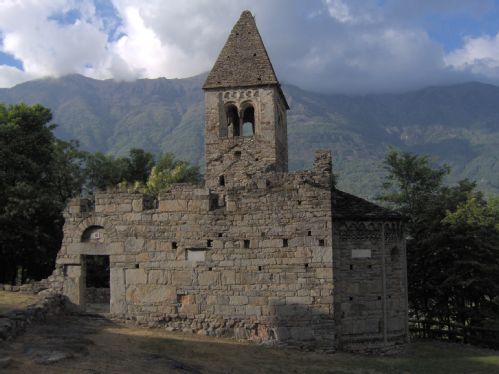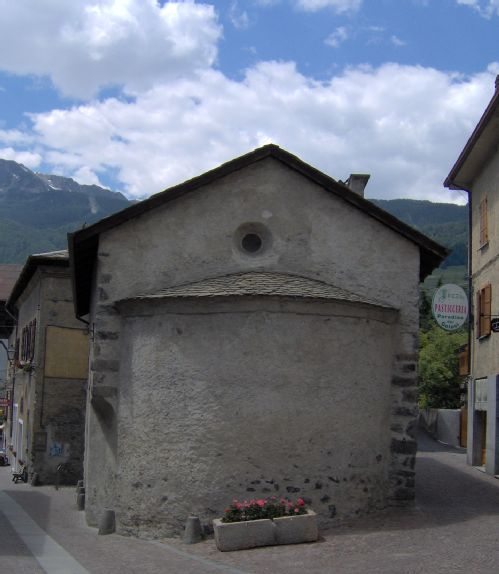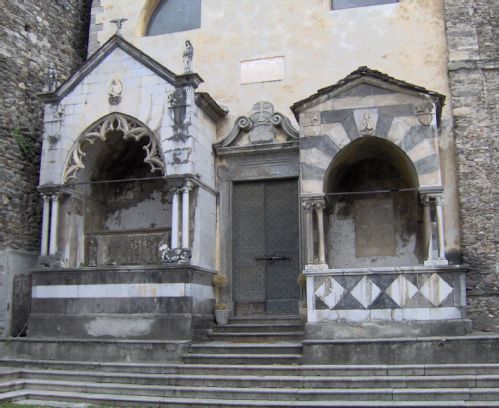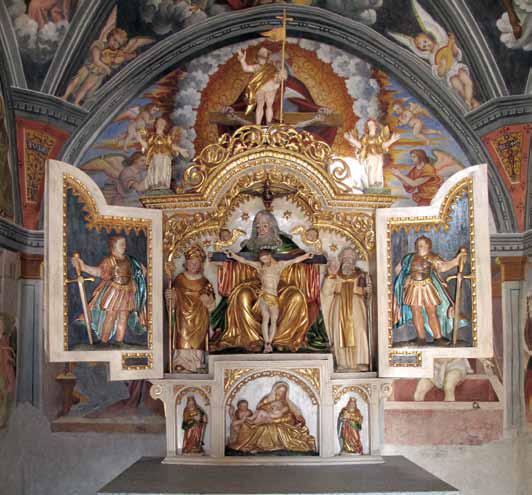Community churches in alpine Lombardy in the late Middle Ages
Until about twenty years ago, most historical studies of ecclesiastical institutions in alpine Lombardy during the late Middle Ages were the passionate work of amateur researchers interested in individual churches, but these publications were devoid of wider conceptual perspectives. The only well-known phenomenon of this period was the division of the districts dependent on the ancient rural matrix churches (pievi) through the development of new parishes, framed in general terms for Italy by Cinzio Violante and for the Lombard area by Giorgio Chittolini and Giancarlo Andenna. It was a convincing interpretation, which focused correctly on the localization of the care of souls but insisted on a process controlled by Church authorities rather than local initiatives.1
Afterwards scholars began to interpret spiritual developments on the ground not as mainly top-down plans developed by the ecclesiastical hierarchy, but as initiatives animated by communities and other protagonists. New research by Paolo Ostinelli and Elisabetta Canobbio on peripheral areas of the dioceses of Milan and Como used the concept of “communalization” previously evolved for other European countries.2 This allowed us to adopt a broader comparative perspective, for example with the religious transformations in the Grisons.3 Indeed, subsequent inquiries have clearly shown how the history of many churches in the area unfolded through several stages of localization and communalization. Although sources for the early Middle Ages are scarce, it can be assumed that original foundations were normally the work of religious and secular elites: bishops, city abbeys and representatives of higher social groups from the region, in the case of St. Peter of Vallate (Cosio; Fig.1) for example a wealthy family from Isola Comacina (the Lake Como island) linked with the monastic network of the Cluniacs.4
 Fig. 1. Ruins of the Cluniac abbey of St. Peter, 1078 (Vallate, Cosio). All photographs by the author.
Fig. 1. Ruins of the Cluniac abbey of St. Peter, 1078 (Vallate, Cosio). All photographs by the author.
Between the fourteenth and the first part of the sixteenth centuries, the domination of bishops and urban monasteries throughout the diocese decreased and local subjects – at first, powerful noble families and subsequently communities – took control of the churches in the villages and in the towns (borghi). The latter acquired the right to manage the benefice and care for the building, to appoint the priest, and determine his salary and duties by means of a notary contract.5 Alongside, communities selected lay parish officials who assumed greater influence over matters of maintenance and equipment, even in conflict with the clergy.
It must be said that the concept of community has become somewhat controversial in recent studies. With particular reference to local religious life, Angelo Torre showed that the unity of the community was often precarious and uncertain. There were endless conflicts between the different settlements that made up the municipality, between the institutions of the parish and the brotherhoods and so on. Ceremonial practices (processions and feasts) could therefore be grounds for strife rather than for the harmony sometimes idealized in the past.6
In my opinion, we should adopt an intermediate and differentiated view. It is true that at the end of the Middle Ages not only the municipalities (comuni), but the smaller units (contrade) of the municipalities or the neighborhoods of the towns founded separate churches with their own sacramental rights. This could occur in opposition to the seat of the communal administration and result in a degree of religious autonomy that the smaller units lacked in civic matters. And it is also true that this set of community rights over the churches stimulated independent initiatives and priorities. In fact, this perspective allows us closer insights into the confessional tensions of the post-Reformation period, beyond the traditional perspective focused on the influence of singular reforming figures (such as the exiles who sought refuge in the Valtellina and Valchiavenna) or the policies of European princes. In fact, conflicts between Catholics and Protestants were often sparked by everyday disputes on the salary of the preacher, the church costs, the use of cemeteries and tower bells. All these rights had become community attributes in the late Middle Ages and aroused quarrels now that the communities were divided by opposing religious beliefs.
On the other hand, local religious life was not always exacerbated by conflict, and sometimes the chapels of the contrade widened their rights and income peacefully within the parish unity. Ceremonies like processions articulated the pluralistic structure of the community – because of the participation of men, women, and children – rather than division. Fraternities were not always exclusive prayer groups separated from the parish. Instead, members were often protected by the community and sponsored artistic works intended for the parish church. In the Bitto Valley, fraternities often comprised all the men and women of the village and carried the name of the parish’s patron saint: in these cases it can be said that the two units were effectively identical.
To go beyond conventional concerns, a fruitful new research path might forge closer connections between institutions, artistic testimony (architecture, sculptures, paintings), devotional practices and beliefs. Such a perspective could also engage with a wider set of visual and material sources besides the ever privileged written documents.
The diffusion of the community churches, in fact, changed religious attitudes. Devotion moved away from the more solemn, clergy-focused liturgy of the pievi, entrusted to the colleges of canons (capitula) promoted by the eleventh-century reform movement. It also departed from the intense spirituality of poverty, retreat from the secular world and charity practiced by the fratres and sorores of the hospitals or by the anchorites who devoted themselves to a church. From the fourteenth century, a simpler and more pragmatic type of worship developed which was closer to the people. Here, the emphasis was on the basic rites as they could be administered by even poorly-trained curates, whom the faithful conceived as an "official of the sacred". Rather than on sophisticated choral singing of the Vespers, greater importance was placed on the sacraments required for salvation, such as confession, communion, and endowed masses for the dead. In other words, what counted was the frequency rather than solemnity of divine service.
Sacred space changed for the same reason. Romanesque pievi and abbeys had large choirs reserved for monks and priests, raised and clearly separated from the laity. The interiors of community churches, in contrast, lacked similar subdivisions and gave greater priority to open naves; in particular the small choirs ("niches"; Fig. 2) would seem totally inadequate to the bishops of the Tridentine reform with their expectations of decorum.7
 Fig. 2. The small chancel niche for the clergy of the church of the Holy Spirit (Bormio).
Fig. 2. The small chancel niche for the clergy of the church of the Holy Spirit (Bormio).
People expressed their presence both outside and inside the churches through the coats of arms of the community or individual families, the latter usually associated with burial places. These tombs, which were widely diffused, occupied their own chapels and, in the case of nobles, sometimes had greater visibility than altars (Fig. 3).8
 Fig. 3. The tombs of the Andriani family (St Thomas Becket, Corenno).
Fig. 3. The tombs of the Andriani family (St Thomas Becket, Corenno).
In the same manner, the iconographic programs reflected lay devotional cultures, i.e. the preferences of the commissioning communities or individuals more than those of the clergy. Paintings and statues expressed people's needs for supernatural protection and local identity. In this religious world animated by municipalities, districts, main towns and smaller villages, sacred art reflected the key importance of social and territorial affiliations. For example, the village of Pedesina, which wished to assert its autonomy from Rasura, decided to build a church that had to be equally high as that of Rasura (1423). The inhabitants of the mountain hamlets of Morbegno, in turn, acquired a wooden altar piece which had to be just as beautiful as the one they had seen in the church of S. Peter in Morbegno (1497).
But as I said, these social groups felt the need to manifest rivalry as well as harmonious relations. For example, all patron saints of the churches in the parish and in the municipality, to which the contrada belonged, are depicted in the (sixteenth-century) frescoes and altar piece of the Holy Trinity chapel at Teregua (Fig. 4), suggesting that the new church was carefully situated within the existing political and ecclesiastical hierarchy. Many other paintings and altar pieces, if seen in their institutional context, similarly reflect the wider sacral landscape through the inclusion of patron saints from nearby churches.

Fig. 4. The wooden altar piece in the Holy Trinity chapel of Teregua (16th Century).
Crosses used in processions and funerals, carrying representations of the patron saints of parish and fraternity (or of the main church as well as dependent chapels of the same parish), sent out the same message. They recognized the complex order of the territory which the faithful used to pass through, and attempted to integrate.
April 2020
Massimo Della Misericordia
English translation revised by Chris Terzi and Beat Kümin
Massimo Della Misericordia is professor of Medieval History (Dipartimento di Scienze umane per la formazione Riccardo Massa - Università degli studi di Milano-Bicocca). His research field is the social, institutional and political history of northern Lombardy in the late Middle Ages. Some essays about ecclesiastical and religious issues summarized in the post are available on the My-Parish site.
Endnotes
1. See e.g. their contributions to Pievi e parrocchie in Italia nel basso Medioevo (sec. XIII-XV), Rome, Herder, 1984.
2. P. Ostinelli, Il governo delle anime. Strutture ecclesiastiche nel Bellinzonese e nelle Valli ambrosiane (XIV-XV secolo), Locarno, Dadò, 1998; E. Canobbio (ed.), La visita pastorale di Gerardo Landriani alla diocesi di Como (1444-1445), Milan, Unicopli, 2001.
3. I. Saulle Hippenmeyer, Nachbarschaft, Pfarrei und Gemeinde in Graubünden. 1400-1600, Chur-Desertina, Bündner Monatsblatt, 1997.
4. See for example, R. Pezzola, A. Rovetta (eds.), La chiesa di San Martino di Cosio Valtellino. Storia, arte, vita religiosa, Morbegno, Ad fontes, 2018.
5. For a comparative vision, see S. Boscani Leoni, P. Ostinelli (eds.), La chiesa «dal basso». Organizzazioni, interazioni e pratiche nel contesto alpino alla fine del medioevo, Milan, Franco Angeli, 2012.
6. A. Torre, Il consumo di devozioni. Religione e comunità nelle campagne dell’Ancien Régime, Venice, Marsilio, 1995.
7. V. Mariotti (ed.), La Valtellina nei secoli. Studi e ricerche archeologiche, Mantua, SAP, 2015.
8. L. Arcangeli, G. Chittolini, F. Del Tredici, E. Rossetti (eds.), Famiglie e spazi sacri nella Lombardia del Rinascimento, Milan, Scalpendi, 2014.
